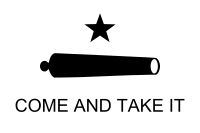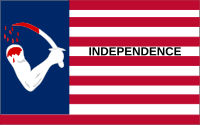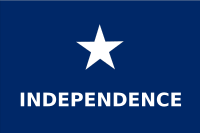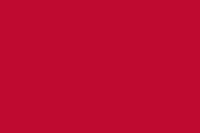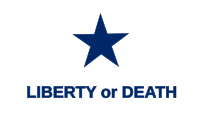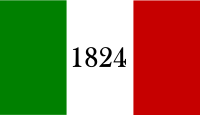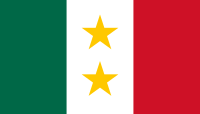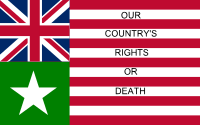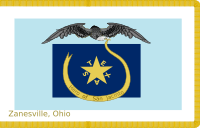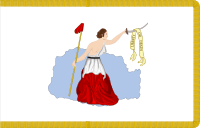Texian Army facts for kids
Quick facts for kids Texian ArmyRevolutionary Army Army of the People |
|
|---|---|
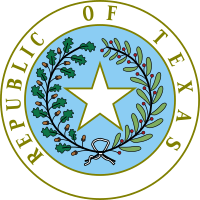 |
|
| Active | October 1, 1835 – April 21, 1836 |
| Country | Republic of Texas |
| Allegiance | Republic of Texas Consultation (Texian provisional government) Constitution of the Republic of Texas |
| Type | Army |
| Role | Land warfare |
| Size | 3,685-3,700 (approximated) |
| Engagements | Texas Revolution
|
| Commanders | |
| Notable commanders |
Stephen F. Austin Sam Houston (WIA) James Fannin (POW) (Executed) William Travis † James Bowie † Davy Crockett † Frank W. Johnson Edward Burleson George Fisher Philip Dimmitt John Linn George Collinsworth Benjamin Milam † William Scott William Ward (POW) (Executed) George H. Burroughs Thomas H. Breece Robert C. Morris Jack Shackelford Juan Seguín Plácido Benavides Salvador Flores Manuel Leal |
The Texian Army was a group of soldiers who fought for Texas during the Texas Revolution. It was also known as the Revolutionary Army or Army of the People. This army formed quickly in October 1835 after the Battle of Gonzales.
Together with the Texian Navy, the Texian Army helped the Republic of Texas win its freedom from Mexico. This happened on May 14, 1836, with the Treaties of Velasco. Even though the Texas Army was officially created in November 1835, the Texian Army continued to fight until after the important Battle of San Jacinto.
Contents
How the Army Started
When Mexico became independent from Spain in 1821, the area of Texas became part of the Mexican state called Coahuila y Tejas. Many people in Texas wanted it to be a separate state again. The Mexican government encouraged people from the United States to move to Texas.
By 1834, about 30,000 English-speaking people lived in Texas. There were only about 7,800 people of Spanish heritage. The Mexican government did not have much money to support Texas with soldiers. So, many towns had small groups of local fighters, called militias, to protect themselves from Native American raids.
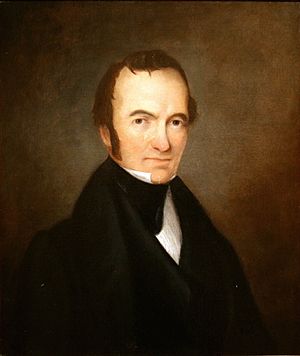
Under President Antonio López de Santa Anna, the Mexican government became more centralized. This meant that Santa Anna had more power. In 1835, he removed the Constitution of 1824 and started ruling like a dictator. This caused people in different parts of Mexico to rebel.
In September 1835, a Mexican commander named Colonel Domingo Ugartechea sent soldiers to get back a small cannon. This cannon had been given to the Texian militia in Gonzales for protection. When the Mexican troops arrived, the Texian commander, Captain Albert Martin, asked them to wait. Martin then sent messages to other English-speaking towns, asking for help to protect the cannon.
Soon, militias from Fayette County and Columbus arrived. In Gonzales, these militias joined together to form the Texian Army. They chose John Henry Moore as their captain. The first fight for this new army was the Battle of Gonzales on October 2, 1835. After a short fight, the Mexican troops left the cannon with the Texians and went back to San Antonio.
After the battle, more colonists gathered in Gonzales. They wanted to end Mexican control over the area. A group called the Committee of Safety in San Felipe named this gathering "The Army of the People."
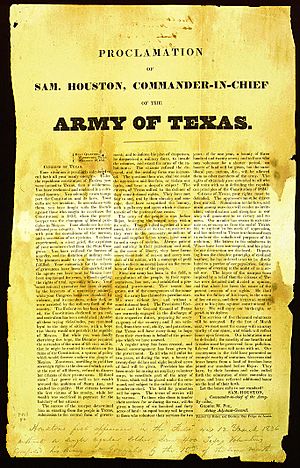
Within a week, the Texians took over the Mexican post at Goliad. On October 11, the volunteers chose Stephen F. Austin as their commander. Austin had helped settle the first English-speaking colonists in Texas in 1821. He had only a little military experience, but he was chosen to lead.
Who Joined the Army?
In 1836, Texas had about 40,000 people. Around 2,000 of them, about 5% of the population, served in the army at some point. The army also had many volunteers from the United States.
In total, about 3,685 men served in the Army of the People between October 1835 and April 1836. Many of these men, about 40%, had moved to Texas after October 1835. Not all of them were American citizens; some were new immigrants from Europe looking for adventure. About one out of every seven English-speaking settlers in Texas joined the army. Also, one out of every three adult male Tejanos (Spanish-speaking settlers in Texas) joined the army.
The army changed a lot over time. There were four main groups of soldiers:
- The army from October to December 1835, which fought in battles like Gonzales and the Siege of Bexar.
- The army from January to March 1836.
- The army from mid-March to April 1836, which fought in the Battle of San Jacinto.
- The army from May to September 1836.
The first army was mostly made up of people who already lived in Texas. Over 1,300 men volunteered in October and November 1835. Most of these men were Texas residents. About half of them were married.
After the Texian victory in Bexar in December, many men went home. By the end of February 1836, fewer than 600 men were left in the army. The new soldiers who joined from January to March 1836 were mostly new to Texas. About 78% of them had arrived from the United States since the fighting began in October. They were younger, with an average age of 27, and most were single.
The army lost many soldiers at the Alamo and Coleto. The government tried to make people join the army, but it was hard because many citizens had fled during the Runaway Scrape. By the Battle of San Jacinto on April 21, Sam Houston had about 1,282 soldiers. Some were sick or on other missions during the battle.
Most of the soldiers at San Jacinto were single, with an average age of 28. In many families, younger sons joined the army while fathers helped women and children move away from the Mexican army.
By the end of May, most Texas residents left the army, thinking the war was over. The army shrank to about 400 men. But fears of a Mexican attack brought more volunteers from the United States. By September, the army grew to 2,500 men. Most of these new soldiers had arrived after the Battle of San Jacinto.
How the Army Was Set Up
The Texian Army was not always organized in a strict way. At first, it was made up of militia members who could come and go as they pleased. To become an officer, a man just needed enough money or charm to convince others to follow him. Many early volunteers came from the United States.
By the end of the war, the army had three main parts:
- The regular army soldiers joined for two years and followed strict army rules.
- Permanent volunteers joined for the whole war. They could choose their own officers. Most of these were Texans who lived there before the war, including both Tejanos and other Texians.
- The volunteer auxiliary corps were mostly new arrivals from the United States. They usually joined for six months.
In November 1835, the Texas government also created "ranging companies" of riflemen. These were like early Texas Rangers.
Army Units
Texian Regular and Volunteer Units
- Texas Rangers (a special police-like unit)
- Infantry (foot soldiers)
- Mounted Volunteers (soldiers on horseback)
- Mounted Gunmen
- Mounted Riflemen
- Spies
- Ranging Corps.
- Mounted Rangers
- Army
- Minute Men (soldiers ready to fight quickly)
- Juan Seguín's Mexican Tejano Volunteers
United States Volunteer Units
- Alabama Red Rovers
- Georgia Battalion
- Huntsville Rovers
- Kentucky Mustangs
- Mississippi Guards
- Missouri Invincibles
- Mobile Greys
- Natchez Mustangs
- New Orleans Greys
- 1st New York Battalion
- 2nd New York Battalion
- North Carolina Volunteers
- Tennessee Mounted Volunteers
- Union Guards
Texian Army Flags
-
Come and Take It Flag
This flag showed a cannon with the words "Come and Take It". It was used at the Battle of Gonzales in October 1835. The Texians used it to challenge the Mexican Army to try and take their cannon. -
Brown's Independence Flag
This flag had a "Bloody Arm" design. Captain William S. Brown supposedly used it during the Mexican Army's Siege of Bexar in late 1835. -
Scott's Liberals Flag
Captain William Scott's "Liberals" used this flag at the Battle of Concepcion on October 28, 1835. -
Red Rovers Flag
This red flag was used by the Red Rovers from Alabama, led by Captain Jack Shackelford. They fought at the Battle of Coleto and the Battle of Goliad. Many of these soldiers were later captured and killed in the Goliad Massacre. -
New Orleans Greys Flag
This flag had an American bald eagle. The New Orleans Greys volunteers used it to help drive the Mexican Army from San Antonio. Many of them were later killed in the Goliad Massacre. Some also fought at the Battle of San Jacinto. -
Troutman Flag
Joanna Troutman designed this flag. The Georgia Battalion, led by William Ward, used it when they marched to fight in Texas. Many of them were killed at the Battle of the Alamo in 1836. -
Alamo Flag
This flag referred to the Mexican Constitution of 1824. It was supposedly flown by the Alamo commanders, William Barret Travis and James Bowie, during the Siege of the Alamo in 1836. -
San Felipe Flag
Gail Borden (famous for condensed milk) supposedly designed this flag. The San Felipe Militia used it, possibly at the Battle of San Jacinto on April 21, 1836. -
Burroughs' Ohio Flag
This flag had an American bald eagle and a white Texas star. Captain George H. Burroughs' militia company from Ohio flew it at the Battle of San Jacinto on April 21, 1836. -
San Jacinto Liberty Flag
This flag showed "Lady Liberty." The Second Regiment of the Texian Army, led by Colonel Sidney Sherman, used it at the Battle of San Jacinto on April 21, 1836. -
Zavala Flag
This was the first official flag of the Republic of Texas, designed by Lorenzo de Zavala. It was in use by March 1836 and was the last official flag of the Texian Army.
Important Texian Army Leaders
-
Commander-In-Chief Major General Sam Houston
-
Colonel James Bowie
-
Colonel Benjamin Milam
-
Lieutenant Colonel William B. Travis
-
Colonel Davy Crockett
-
First Lieutenant Benjamin McCulloch
Famous Soldiers
- John M. Allen (soldier), first mayor of Galveston
- Moseley Baker, politician in Alabama and Texas
- Gail Borden, invented condensed milk
- Andrew Briscoe, signed the Texas Declaration of Independence
- Benjamin F. Bryant, founded a frontier fort and was a Texas Ranger
- Henry Eustace McCulloch, Texas Ranger and Confederate general
- Joel Walter Robison
- Juan Seguín, signed the Texas Declaration of Independence; a town is named after him
- Deaf Smith, led Texas Rangers; a county is named after him
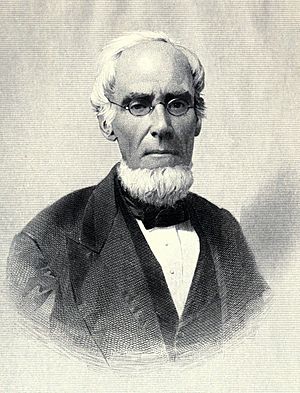
Uniforms and Equipment
The Texian Army soldiers did not have official uniforms. Some groups from the United States bought old U.S. Army uniforms. Other groups had simple "uniforms" like matching hunting shirts.
A Texian volunteer named Noah Smithwick described the army in October 1835: "It was hard to describe how the first Texas army looked when it was ready to march. Many wore buckskin pants, some new and soft, others old and worn. Some had shoes, some moccasins. Hats were all different, from wide sombreros to coonskin caps. Instead of water bottles, they carried Spanish gourds. Horses were also varied, from large American horses to small Spanish ponies. It looked like a strange army, but everyone had the same goal, which made them feel united."
Key Battles and Events
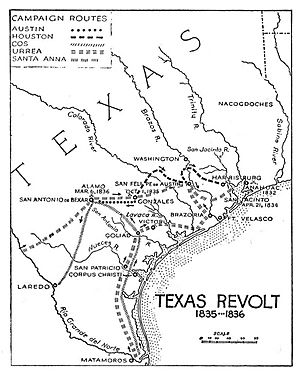
Early Fights (October – December 1835)
After Austin became commander, the army marched towards Bexar. They wanted to face General Martin Perfecto de Cos, who led the Mexican troops in Texas.

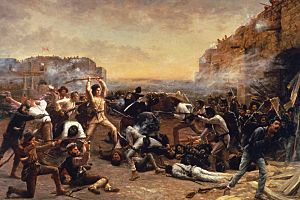
Changes in the Army (December 1835 – February 1836)
The official regular army was created on December 12. Men who joined the regular army would get money, land, and Texas citizenship. Those who joined the volunteer groups would also get land.
The commander of the regular forces, Sam Houston, wanted 5,000 men to join. But it was hard to convince them. Many volunteers from the United States did not want strict military rules. They preferred to join informal volunteer groups.
The Texas government was very low on money. On January 6, 1836, Colonel James C. Neill, who led 100 soldiers in Bexar, wrote that they had no money. He said that clothing meant for his men was taken and given to new soldiers.
For several months, it was unclear who was truly in charge of the Texian army.
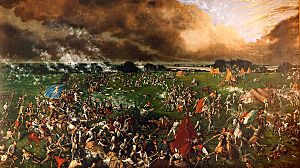
Defending Texas (March – April 1836)
The Mexican army returned to Texas in February. They began a siege of the Texian soldiers in San Antonio on February 23. The commander at the Alamo, William B. Travis, sent many letters asking for help. Men gathered in Gonzales to reinforce the Alamo.
However, before they could arrive, the Mexican army attacked in the Battle of the Alamo. All the Texian soldiers there were killed. This left two main groups of the Texian Army: Fannin's 400 men at Goliad and Neill's 400 men at Gonzales.
When Sam Houston heard about the Alamo, he ordered his army to retreat. They burned the town of Gonzales as they left. He also told Fannin to bring his men and join the main army. But Fannin's group was defeated at the Battle of Coleto Creek. On March 27, Fannin and his men were executed in the Goliad Massacre. A few soldiers escaped, and some new arrivals from the United States were spared.
As news of the Alamo and Goliad spread, more men joined the Texian army. By early April, Houston had about 800 men. The Texas Revolution mostly ended on April 21. The Texian Army defeated a Mexican force and captured Santa Anna at the Battle of San Jacinto.
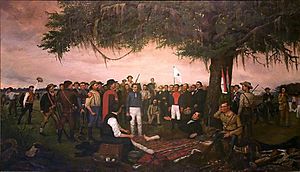
After the War
After the war, the Texian Army continued to exist as the main defense force for the new Republic of Texas.
In Movies and TV
- 1960: The Alamo, a movie about the Battle of the Alamo.
- 2004: The Alamo, another movie about the Battle of the Alamo.
- 2015: Texas Rising, a TV miniseries about the Texas Revolution.
- 2018: The Men Who Built America: Frontiersmen ("Empire or Liberty"), a TV episode about the Battle of the Alamo.



